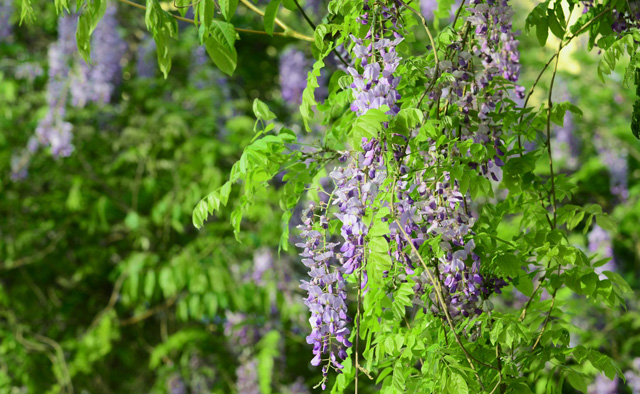Make the most of wisteria
Tom Coward shares his tips for making the most of your wisteria; planting and pruning these tough but rewarding plants


A beautiful wisteria in full flower is one of the most captivating sights any garden can muster. At Gravetye, wisterias run wild through trees, are trained on walls and, perhaps most effectively, grown on pergolas so that the flowers hang down to eye level. One of our most prominent is an ancient Wisteria floribunda Alba growing on a pergola at the back of the flower garden. It forms a wonderful backdrop to our plantings and we’ve been having a lot of fun growing the white lupin Noble Maiden under it, to create a ‘stalagmites and stalactites’ effect.
By the end of summer, however, the wisterias’ vigour could turn them from a knockout show to a tangled mess, so some serious summer pruning is needed now, to pull them into shape. There are about 10 species in the genus, but the two most commonly grown are the Chinese W. sinensis, which grows up in an anti-clock-wise spiral, and the Japanese W. floribunda, which grows clockwise. W. sinensis flowers early, before the leaves open, and has the best scent, but it is susceptible to frosts. Both varieties can be very vigorous; the biggest known wisteria plant is in California and covers more than an acre, but even in our mild British climate, their growth rate can be astonishing.
Where the wisterias run wild in the trees, we seldom bother with summer pruning, unless they’re damaging their host, but on buildings, they need special care. Their long, whippy shoots can cause a lot of damage by scrambling under roofing tiles and can pull off gutters and downpipes.
On pergolas, a summer haircut is also very important to prevent the path becoming overgrown within a thick, dark, unattractive tunnel. Every year in late July or August, we cut back all of the new growths to just five leaves, which makes the plant presentable again. It also encourages better flowering next year by forcing the plant to put energy into making flowering spurs, instead of creating excessive growth.
The next phase of pruning will take place at the end of winter; the shoots will be cut back again, this time to leave just three buds. Any congested growth can also be cut out to encourage bigger flowers, which hang freely. It may seem like a lot of work to prune twice, but it really is worth it.
Spring or autumn is the best time to plant new wisteria, but, because they’re such vigorous, long-lived things, serious thought needs to be put in to their position and support. A free-draining, well-prepared soil is important, but frost pockets are obviously a bad idea.
Wisterias can handle a bit of shade, but they perform best in full sun. It’s possible to grow them up a stake and prune them into a standard, which can work well for a small garden, but to really enjoy the full beauty of the plant, I think it’s best to let them climb, as nature intended.
Exquisite houses, the beauty of Nature, and how to get the most from your life, straight to your inbox.
If you’re planting one to romp through a tree, it’s important that the host tree is big and tough enough to handle the burden. We dig out a large planting pit below the drip line of the tree, about 3ft square, and remove all the tree roots to give the wisteria a chance to establish.
The danger with pergolas is that they can become very overgrown, but planting on alternate uprights can prevent this. It’s important to select a material for the construction that’s strong enough and durable enough to last, for most wisteria will outlive their supports.
At Gravetye, we’ve replaced a pergola that had rotted under an enormous plant that was more than 100 years old. It was quite a daunting job, but by lifting the plant with a digger and propping it, we were able to slide the new pergola supports in and, after a heavy prune, it soon bounced back. These are beautiful plants, but perhaps one of their greatest assets is that they really are as tough as old boots!
* This article was first published in Country Life magazine on July 23 2014
